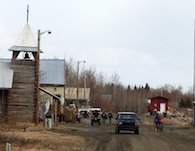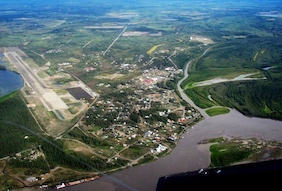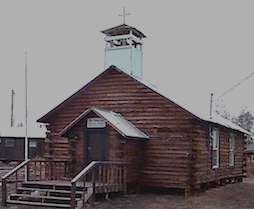 Tanana: The village of Tanana is located at the confluence of the Tanana and Yukon Rivers, approximately 130-140 air miles northwest of Fairbanks, Alaska. The community is located at a traditional site where Athabascan Indians gathered to trade. The community has a long history of western fur traders and their trading posts and was where the U.S. military established Fort Gibbon in 1899 during the Klondike Gold Rush. For many years, Tanana was the location of a regional hospital serving the interior river villages. The village is centrally located to take advantage of annual salmon runs and a diverse subsistence base of moose, waterfowl, and fur species.
Tanana: The village of Tanana is located at the confluence of the Tanana and Yukon Rivers, approximately 130-140 air miles northwest of Fairbanks, Alaska. The community is located at a traditional site where Athabascan Indians gathered to trade. The community has a long history of western fur traders and their trading posts and was where the U.S. military established Fort Gibbon in 1899 during the Klondike Gold Rush. For many years, Tanana was the location of a regional hospital serving the interior river villages. The village is centrally located to take advantage of annual salmon runs and a diverse subsistence base of moose, waterfowl, and fur species.
 Fort Yukon: Fort Yukon is located at the juncture of the Yukon and Porcupine Rivers, approximately 150 air miles north east of Fairbanks, Alaska. In 1847, this is where the Hudson Bay Company established their first fur trading post in Interior Alaska. Today, Fort Yukon is a regional center for villages in the middle and upper Yukon and is located on what is commonly referred to as the “Yukon Flats” because of the low lying topography and the numerous lakes and sloughs. This is a prime location for waterfowl, moose, and fur trapping.
Fort Yukon: Fort Yukon is located at the juncture of the Yukon and Porcupine Rivers, approximately 150 air miles north east of Fairbanks, Alaska. In 1847, this is where the Hudson Bay Company established their first fur trading post in Interior Alaska. Today, Fort Yukon is a regional center for villages in the middle and upper Yukon and is located on what is commonly referred to as the “Yukon Flats” because of the low lying topography and the numerous lakes and sloughs. This is a prime location for waterfowl, moose, and fur trapping.
 Chalkyitsik: Chalkyitsik is a small village located about 50 air miles east of Fort Yukon on the Black River, a tributary of the Porcupine River. The village is located at a traditional fishing site that became a permanent village when a barge headed further up the river and hauling building supplies for the school was stopped by low water and forced to unload. The area is known for its abundance of waterfowl, moose, and muskrats.
Chalkyitsik: Chalkyitsik is a small village located about 50 air miles east of Fort Yukon on the Black River, a tributary of the Porcupine River. The village is located at a traditional fishing site that became a permanent village when a barge headed further up the river and hauling building supplies for the school was stopped by low water and forced to unload. The area is known for its abundance of waterfowl, moose, and muskrats.

